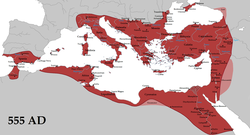
Back Keurajeuën Bizantium ACE Бизантие Империэ ADY Bisantynse Ryk Afrikaans Byzantinisches Reich ALS ቢዛንታይን መንግሥት Amharic Imperio Bizantín AN Constantinopolis Rice ANG الإمبراطورية البيزنطية Arabic لإمبراطورية لبيزنطية ARY امبراطوريه بيزنطيه ARZ
The English used in this article or section may not be easy for everybody to understand. (September 2024) |
Roman Empire | |
|---|---|
| 330/395–1453b | |
 The empire in 555 under Justinian the Great, at its greatest extent since the fall of the Western Roman Empire (its vassals in pink) | |
 The territorial evolution of the Eastern Roman Empire under each imperial dynasty until its fall in 1453. | |
| Status | Eastern division of the Roman Empire[1] |
| Capital | Constantinople (modern-day Istanbul)c |
| Common languages | |
| Religion |
|
| Demonym(s) | Rhōmaîoi |
| Notable emperors | |
• 306–337 | Constantine I (first) |
• 408–450 | Theodosius II |
• 474–475, 476–491 | Zeno |
• 527–565 | Justinian I |
• 582–602 | Maurice |
• 610–641 | Heraclius |
• 717–741 | Leo III |
• 797–802 | Irene |
• 867–886 | Basil I |
• 976–1025 | Basil II |
• 1081–1118 | Alexios I |
• 1143–1180 | Manuel I |
• 1261–1282 | Michael VIII |
• 1449–1453 | Constantine XI |
| Historical era | Late Antiquity to Late Middle Ages |
• First East–West division of the Roman Empire | 1 April 286 |
| 11 May 330 | |
• Final East–West division after the death of Theodosius I | 17 January 395 |
• Fall of the West; deposition of Romulus | 4 September 476 |
• Assassination of Julius Nepos | 9 May 480 |
• Early Muslim conquests; start of the Dark Ages | 634–750 |
• Battle of Manzikert; loss of Anatolia due to following civil war | 26 August 1071 |
• Sack of Constantinople by Catholic crusaders | 12 April 1204 |
| 25 July 1261 | |
| 29 May 1453 | |
| 29 May 1460 | |
| 15 August 1461 | |
| Population | |
• 457 | 16,000,000f |
• 565 | 26,000,000 |
• 775 | 7,000,000 |
• 1025 | 12,000,000 |
• 1320 | 2,000,000 |
| Currency | Solidus, denarius and hyperpyron |
| |
The Byzantine Empire, also referred to as the Eastern Roman Empire, was the continuation of the Roman Empire primarily in its eastern provinces that survived into the Late Antiquity and the Middle Ages. The capital of the empire was Constantinople. It survived the fall of the Western Roman Empire in the 5th century AD and continued to exist until the fall of Constantinople to the Ottoman Empire in 1453.
- ↑ "Byzantine Greek language". Encyclopedia Britannica. Archived from the original on 17 July 2021. Retrieved 21 August 2021.
- ↑ Treadgold 1997, p. 734